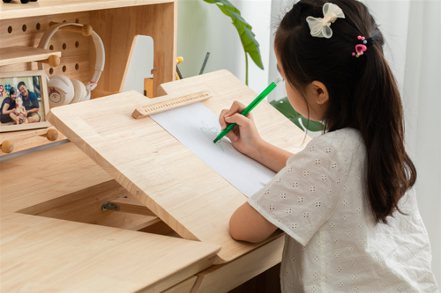There are countless types of children's desks and chairs on the market, and in the era of inflation, cost-effectiveness is more important. Some companies have developed "growing-with-your child-desks" that claim to be suitable for children from primary school students to doctoral students. The ability to use the desk for decades has caught the attention of many parents.
Four key points for choosing children's furniture
"Non-toxic materials, ergonomic design, storage functionality, and good after-sales service" are the four most important points for choosing children's furniture. Chang Chia Hsiang, the founder of HA Furniture, who has been engaging in the research and development of related products for over 10 years, pointed out that the primary consideration for children's furniture is "material." This is not only because children's skin is very delicate, but also because furniture with poor materials can potentially cause injuries to children during use. It is recommended to prioritize "solid wood furniture" when making selections.
Non-toxic materials are paramount, and zero formaldehyde is crucial.
When buying products with zero formaldehyde, solid wood is a better choice in comparison.
Solid wood requires less processing, and in order to prevent wood from getting damp, have antibacterial properties, and resist mold, the wood coatings must undergo multiple inspections and meet the true non-toxic standards, which include not containing eight heavy metals, TVOC (Total Volatile Organic compounds), formaldehyde, etc. This ensures the safety of both adults and children when using them. Although many manufacturers claim to use low-formaldehyde engineered wood panels, they may not provide clear inspection reports. When purchasing, consumers can request the manufacturer to provide formaldehyde content inspection reports, and it is important to clearly indicate the credibility of the testing laboratory.
Ergonomics is essential.
"Children must sit comfortably to be willing to sit and concentrate on learning." Chang Chia Hsiang mentioned that when furniture does not match the child's body shape, it can easily lead to bad posture and hunchback. When children sit comfortably and willingly sit down to learn, buying a good desk is definitely the best investment for children.
Storage functionality cultivates good habits in children.
Many parents often overlook storage functionality. Taking HA Furniture as an example, each desk and chair not only has drawers but also incorporates interesting designs using the space on the side of the desk. Chang Chia Hsiang puts forward a more important educational concept, believing that "storage should not be for the sake of storage." The purpose of storage functionality is to help children "develop the habit" of knowing that each item around them has its own "home."
Satisfactory trial guarantee, honest after-sales service.
Parents are afraid that the desk won't fit in the house or that it may not be practical despite having multiple functions. Therefore, the ability to try out the desk is crucial. For example, HA Furniture allows consumers to try their products for 30 days, and they can return them if they are not satisfied. This is the most generous trial guarantee among all brands.
In addition, since the desk will be used for decades, parents should not overlook the importance of after-sales service. Experts suggest that when making a purchase, pay attention to the safety of the product's materials, clear and explicit inspection reports from testing laboratories, the use of non-toxic water-based wood coatings, whether they have passed SGS and FDA food contact testing, and the availability of good repair and refurbishment services as considerations for purchasing.
Article excerpted from the Economic Daily <original source>

